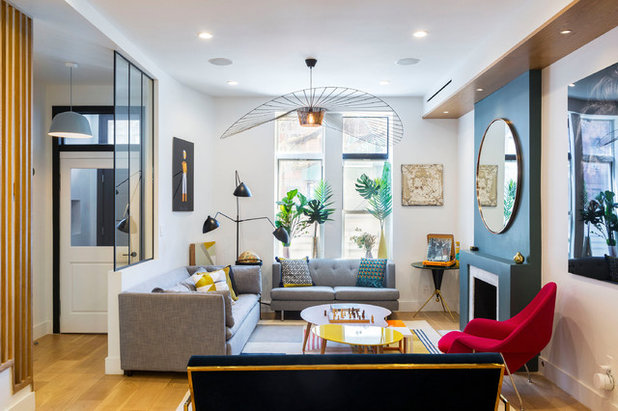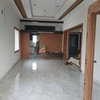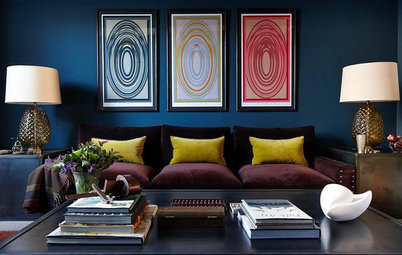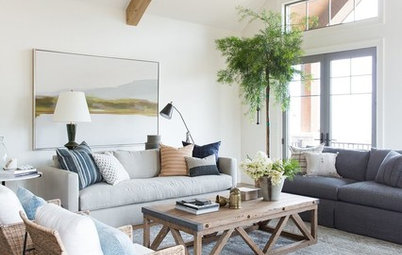How to Make Your Living Room Look Bigger
Decorating a small living room? These 10 tips will help you make it more beautiful and welcoming
Neila Deen
3 March 2022
If you don’t have room for a 10ft sofa or giant media console, you’re not alone. Those of us who live in a flat or urban area frequently find space is at a premium. If this describes your experience, you can choose to look at your limited living space as a creative design challenge.
The key to living happily and beautifully in small quarters is combining space-saving and multifunctional solutions while expressing your personal style. Smart decisions will give you the space you need while making your room personal and welcoming.
The key to living happily and beautifully in small quarters is combining space-saving and multifunctional solutions while expressing your personal style. Smart decisions will give you the space you need while making your room personal and welcoming.
1. Open it up to other rooms
If you have a limited living area, you may want to view it as a flowing space and, where possible, open up doorways or walls so adjacent rooms can merge.
A living room can be a larger combination of a living, dining and kitchen space if you take down the walls that separate them. Likewise, widening doorways and opening them up to the ceiling will create a more open feeling. If making major structural changes isn’t possible, try simply removing the doors to each connected space.
This not only will improve the sightlines and light in each room, it will allow for an easier flow of movement.
If you have a limited living area, you may want to view it as a flowing space and, where possible, open up doorways or walls so adjacent rooms can merge.
A living room can be a larger combination of a living, dining and kitchen space if you take down the walls that separate them. Likewise, widening doorways and opening them up to the ceiling will create a more open feeling. If making major structural changes isn’t possible, try simply removing the doors to each connected space.
This not only will improve the sightlines and light in each room, it will allow for an easier flow of movement.
2. Use built-in furniture and shelves
It’s a good idea to invest in built-in solutions and appropriate shelving to fit your space and needs. Bespoke units are ideal in a small room because you can size each piece of furniture for your challenging space while adding a feature or two that maximises its use. For example, a built-in sofa can have useful storage hidden underneath.
If hiring a carpenter or commissioning a bespoke piece isn’t in your budget, get creative. Could you place an attractive rollaway unit underneath your sofa? How about floating a deep shelf with brackets on a wall as a desk?
Similarly, instead of a custom-made wall unit, place shelves in an artful pattern on a wall to create a media unit. When hanging shelves, fit them all the way up a wall to create a vertical pattern. Higher placement of design features helps to create the feeling of volume in the room.
It’s a good idea to invest in built-in solutions and appropriate shelving to fit your space and needs. Bespoke units are ideal in a small room because you can size each piece of furniture for your challenging space while adding a feature or two that maximises its use. For example, a built-in sofa can have useful storage hidden underneath.
If hiring a carpenter or commissioning a bespoke piece isn’t in your budget, get creative. Could you place an attractive rollaway unit underneath your sofa? How about floating a deep shelf with brackets on a wall as a desk?
Similarly, instead of a custom-made wall unit, place shelves in an artful pattern on a wall to create a media unit. When hanging shelves, fit them all the way up a wall to create a vertical pattern. Higher placement of design features helps to create the feeling of volume in the room.
3. Get creative with your furniture layout and lighting
Where possible, try arranging furniture to create separation between functional zones. This helps to define different uses within a single room. For example, place a desk behind a sofa to fashion a workspace, or arrange your chairs and sofa in a way that clearly separates the living room from the dining space.
You can further define the layout by placing a different ceiling light in each separate space. For example, in the living area, you could choose a light that sits close to the ceiling, then in the adjacent dining space, you could hang a pendant directly over the table.
Where possible, try arranging furniture to create separation between functional zones. This helps to define different uses within a single room. For example, place a desk behind a sofa to fashion a workspace, or arrange your chairs and sofa in a way that clearly separates the living room from the dining space.
You can further define the layout by placing a different ceiling light in each separate space. For example, in the living area, you could choose a light that sits close to the ceiling, then in the adjacent dining space, you could hang a pendant directly over the table.
4. Let the sun shine in
Emphasise your natural light sources to make your room brighter. A sunlit room feels more open and helps eliminate shadows that can make an enclosed area feel smaller.
The simplest way to enhance natural light in a room is to place a mirror where it will reflect the light from a window. This won’t only reflect light, it will create the illusion of more depth in the space, too. When possible, place your most-used pieces of furniture – such as the sofa or your favourite cosy chair – so they afford a view of the outdoors.
If natural light is minimal, consider installing track lighting. iIts bright light and flexible track heads can substitute for direct sunlight while not taking up valuable table or floor space.
Emphasise your natural light sources to make your room brighter. A sunlit room feels more open and helps eliminate shadows that can make an enclosed area feel smaller.
The simplest way to enhance natural light in a room is to place a mirror where it will reflect the light from a window. This won’t only reflect light, it will create the illusion of more depth in the space, too. When possible, place your most-used pieces of furniture – such as the sofa or your favourite cosy chair – so they afford a view of the outdoors.
If natural light is minimal, consider installing track lighting. iIts bright light and flexible track heads can substitute for direct sunlight while not taking up valuable table or floor space.
5. Paint strategically
The classic tip of using white or paler hues is still spot-on for painting a smaller space. Also, painting the woodwork and walls in the room the same colour draws the eye up and highlights the ceiling, as in this room.
Ready for a refresh? Find designers in your area.
The classic tip of using white or paler hues is still spot-on for painting a smaller space. Also, painting the woodwork and walls in the room the same colour draws the eye up and highlights the ceiling, as in this room.
Ready for a refresh? Find designers in your area.
However, you can also use darker colours. Soothing hues such as navy or charcoal grey, for example, can make a smaller space stylishly inviting. The trick in a small room is to balance a darker wall with lighter elements to create depth and brighten the room.
For example, place a lighter-coloured sofa against a dark wall. Layer with more light-coloured furniture, shiny accessories and a pale rug.
For example, place a lighter-coloured sofa against a dark wall. Layer with more light-coloured furniture, shiny accessories and a pale rug.
6. Ditch the overstuffed sofa
This may be rather obvious, but it’s important: avoid oversized and heavy-feeling furniture – it will take over and make the room feel smaller. Instead, opt for low-profile, streamlined pieces, particularly where sofas are concerned.
Low-profile furniture essentially means low to the ground. A low-profile sofa, for example, means there’s a small distance from the floor to the sofa seat. From a design standpoint, this usually means smaller legs, streamlined cushions or a narrow base.
Use the extra wall space your low-profile sofa provides to balance the space with artwork that starts low and goes high. Great examples are hanging a large-scale art piece or arranging a vertical row of shelves that draws the eye up.
This may be rather obvious, but it’s important: avoid oversized and heavy-feeling furniture – it will take over and make the room feel smaller. Instead, opt for low-profile, streamlined pieces, particularly where sofas are concerned.
Low-profile furniture essentially means low to the ground. A low-profile sofa, for example, means there’s a small distance from the floor to the sofa seat. From a design standpoint, this usually means smaller legs, streamlined cushions or a narrow base.
Use the extra wall space your low-profile sofa provides to balance the space with artwork that starts low and goes high. Great examples are hanging a large-scale art piece or arranging a vertical row of shelves that draws the eye up.
7. Choose multitasking pieces
When living small, it’s imperative you ask yourself: Could this serve more than one purpose? By having key pieces do double duty, you can easily accommodate all your living room needs. Perfect examples are a console table or wall unit as a desk and the highly useful pullout sofa-bed.
Storage is another useful feature to add anywhere it can fit. Instead of dining chairs, perhaps try a bench with hidden storage. Instead of floating shelving, opt for floating drawers. They serve the same purpose and give you extra compartments for necessities. Similarly, place a tray on top of a storage ottoman to serve as a multifunctional coffee table.
When living small, it’s imperative you ask yourself: Could this serve more than one purpose? By having key pieces do double duty, you can easily accommodate all your living room needs. Perfect examples are a console table or wall unit as a desk and the highly useful pullout sofa-bed.
Storage is another useful feature to add anywhere it can fit. Instead of dining chairs, perhaps try a bench with hidden storage. Instead of floating shelving, opt for floating drawers. They serve the same purpose and give you extra compartments for necessities. Similarly, place a tray on top of a storage ottoman to serve as a multifunctional coffee table.
8. Go big with a rug
It might seem counterintuitive, but, where possible, use a rug that extends beyond the furniture in each functional space.
For example, in a living area, a rug that sits under the sofa, coffee table and additional seating will draw the eye wider and make that living space appear bigger. On the other hand, a smaller rug sized just a bit larger than the coffee table can feel more like a bath mat, causing the living space to read as its limited size.
It might seem counterintuitive, but, where possible, use a rug that extends beyond the furniture in each functional space.
For example, in a living area, a rug that sits under the sofa, coffee table and additional seating will draw the eye wider and make that living space appear bigger. On the other hand, a smaller rug sized just a bit larger than the coffee table can feel more like a bath mat, causing the living space to read as its limited size.
9. Create a focal point
Take advantage of your living room’s diminutive size to easily create a design feature. Specifically, choose one aspect of the room to highlight with something visually interesting. The eye will immediately be drawn to this standout feature, with less emphasis on the room’s challenging size.
A good example is to design a feature wall behind a sofa with colour, texture or artworks. Use a wall covering such as grasscloth, feature a mural or place different framed artworks and mirrors on a brightly coloured wall.
Take advantage of your living room’s diminutive size to easily create a design feature. Specifically, choose one aspect of the room to highlight with something visually interesting. The eye will immediately be drawn to this standout feature, with less emphasis on the room’s challenging size.
A good example is to design a feature wall behind a sofa with colour, texture or artworks. Use a wall covering such as grasscloth, feature a mural or place different framed artworks and mirrors on a brightly coloured wall.
10. Express yourself, don’t repress yourself
Just because you’re living small doesn’t mean you can’t include stylish features that represent you. In a small room, it’s easy for the furniture to take over the personality of the room.
Since the living room is where we spend a lot of time, imbue yours with personality via accessories that tell the story of you and your household. Creatively framed photos, a sentimental object from a grandparent, or personal artwork or collections are great one-of-a-kind decorative elements that personalise your cosy living room.
Tell us:
Which of these ideas would you use in your own home? Share your thoughts in the Comments.
Just because you’re living small doesn’t mean you can’t include stylish features that represent you. In a small room, it’s easy for the furniture to take over the personality of the room.
Since the living room is where we spend a lot of time, imbue yours with personality via accessories that tell the story of you and your household. Creatively framed photos, a sentimental object from a grandparent, or personal artwork or collections are great one-of-a-kind decorative elements that personalise your cosy living room.
Tell us:
Which of these ideas would you use in your own home? Share your thoughts in the Comments.
Related Stories
Photo Books
30 Best Sofa Designs
This guide gives a rundown of sofa types that will leave you spoilt for choices
Full Story
Decorating Ideas
12 Sofa Colour Combinations You Can Blindly Trust
We've put together a tasteful mix of sofa shades that can take your living room from meh to magnificent
Full Story
Indian Homes
Design-Forward Indian Living Rooms, Bedrooms & Kitchens on Houzz
Take cues, ideas and inspiration from this compilation of 50 inspiring Indian spaces
Full Story
Most Popular
Which False Ceiling Material is Better: Gypsum or POP?
Here is all you need to know about the difference between gypsum and POP before you commit to a ceiling
Full Story
Small Spaces
9 Seating Arrangement Ideas for Small Living Rooms
Discover ways to live large with these pocket-sized living areas
Full Story
Colour Guides
5 Best Colours for Small Living Rooms
These paint colours will set the mood, update your space and make a small space seem larger than it is
Full Story
Dining Rooms
Remarkable Pairings: 40 Gorgeous Living Dining Combos
Here are inspiring living and dining room ideas for small and big spaces
Full Story
Decorating Guides
Contemporary Chic: How to Design a Modern Rustic Living Room
Love natural, rustic style, but want to keep it contemporary? Take a look at these design ideas
Full Story
Colour Guides
What Colour Curtains Go With Cream Walls?
Here are exciting and surprising curtain colours that match cream walls
Full Story






























I really like open spaces, so an open living room is a must-have in my home.
My den is only 12 X 14. It is open to the kitchen and has really high ceilings. The windows let in a ton of natural light. The staircase is in here vs. the living room and is open. As a result, the room doesn't feel small!
Definitely big rug! And no chunky sofas !